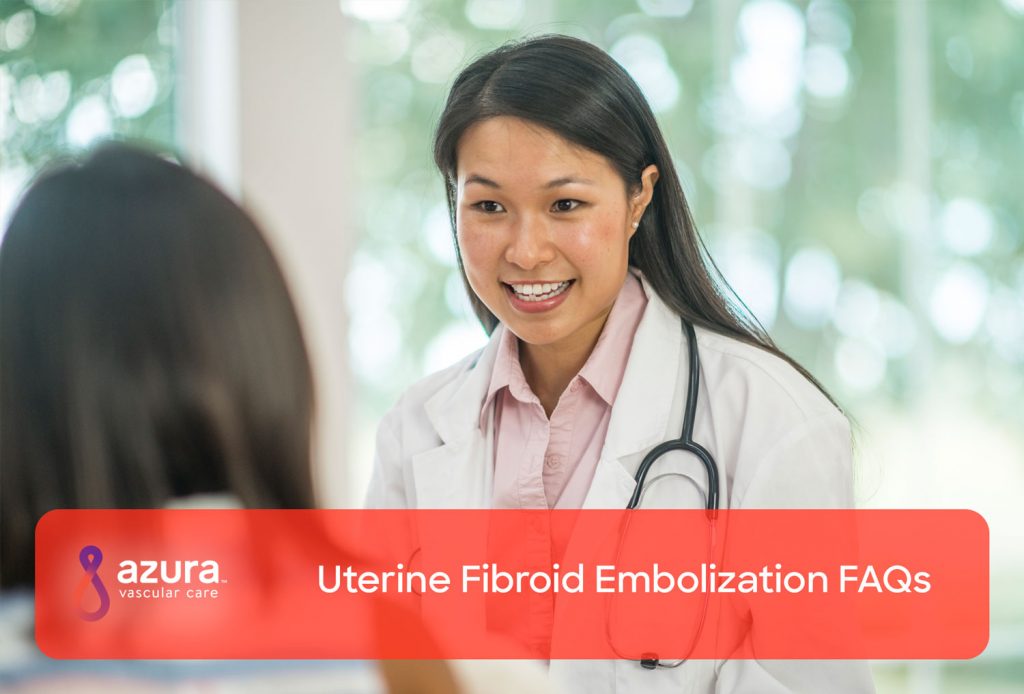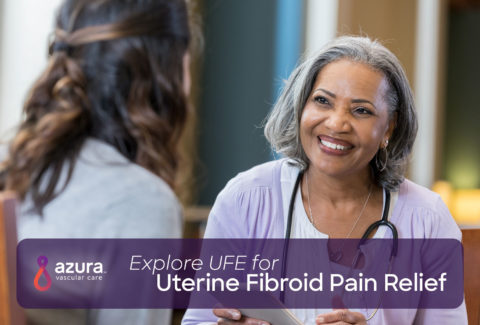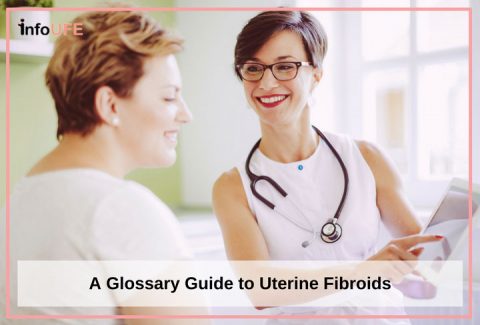
If you have been suffering from the pain and discomfort of uterine fibroids and don’t want a hysterectomy, you should learn about uterine fibroid embolization (UFE). This minimally invasive, outpatient procedure provides relief from symptoms and a quick recovery. Recommended by the American College of Obstetrician and Gynecologists, UFE shrinks fibroids rapidly eliminating the painful symptoms without the need for surgery.
Like most women with uterine fibroids, you may have many questions about your treatment options. Within this article, you’ll find detailed information about uterine fibroids and the UFE procedure as a treatment option.
Making the Diagnosis
What are symptoms of fibroids?
Heavy bleeding (which can be heavy enough to cause low blood count) or painful periods, feeling of fullness in the pelvic area (lower stomach area), frequent urination, pain during sex, lower back pain, constipation or bloating.
All patients must have a thorough gynecologic examination to be certain that fibroids are indeed the cause of their symptoms. All patients must have an MRI examination and we recommend a Pap smear result from a test performed within the past 12 months. Most patients who complain of bleeding will have an endometrial biopsy, an outpatient gynecologic procedure that is performed to rule out cancer in the lining of the uterus.
Learn more about the signs and symptoms of uterine fibroids.
How are fibroids diagnosed?
Fibroids are usually detected during a routine gynecologic exam when the patient’s gynecologist feels an enlarged uterus. The diagnosis may be confirmed using ultrasound or, less commonly, MRI. MRI aids in determining the exact size, number and location of the fibroids and provides information concerning the blood supply to the fibroids that ultrasound cannot provide.
Are fibroids cancerous?
No. Uterine fibroids (leiomyomas) are benign tumors, non-cancerous growths that develop in the muscular walls of the uterus.
The UFE Procedure
What is uterine fibroid embolization (UFE)?
Uterine Fibroid Embolization (UFE) is a procedure during which a catheter is guided through the uterine artery with the use of fluoroscopy, a moving x-ray. Tiny particles, known as embolization spheres, are injected into the uterine arteries that supply blood to the fibroid tumor. These spheres block blood flow to the fibroid tumor causing the fibroid(s) to shrink, and ultimately die off, resulting in relief of the symptoms.
What is the success rate of UFE?
According to the combined results of major studies of UFE, the average success rate is approximately 90%. After five years, approximately 80% of patients are asymptomatic. In other words, in 4 out of 5 patients, it is not necessary to have a hysterectomy or other treatment for uterine fibroid disease.
What are the risks and side effects of UFE?
Although UFE is very safe and carries less risk than surgery, any medical procedure has some potential side effects or risks. Most women experience moderate to severe pain and cramping during the first several hours after the procedure, and some also experience nausea and low grade fever. All of these can be successfully controlled with appropriate pain medications. It is uncommon to have a low-grade fever, mild nausea, and malaise for more than 3-4 days after the embolization. In a very small number of cases (3-4 percent), infection is a complication. This can usually be controlled with antibiotics. In less than 1% of the procedures, serious complications occur and a hysterectomy is needed.
A small number of patients have reported beginning menopause after the procedure, but this is not a common occurrence for women under the age of 45. Older women who are approaching or exhibiting signs of menopause do have an increased risk.
Is general anesthesia required?
No. UFE is performed under monitored conscious sedation. This means you will be sedated but arousable during the procedure. A local anesthetic is used to numb the site where the physician inserts the catheter. UFE is well tolerated, and many patients don’t remember anything about the procedure due to the effects of the “twilight” sedation.
Is the procedure painful?
The procedure itself is not painful. Most women experience moderate to severe pain and cramping during the first 8-12 hours after the procedure. The use of intravenous and/or oral pain medications makes any pain tolerable.
Is an overnight stay required?
No, the procedure is performed in an outpatient setting so you will go home the same day. Someone will need to drive you to and from the procedure because you will receive sedation and be on pain medications.
Is there a limit to the number and size of fibroids that can be treated?
There is no limit on the number of fibroids we can treat. One of the advantages of UFE is that it treats all fibroids at once. In some cases, there may be a lower success rate for very large fibroids (uterus size equal to or more than 24 weeks pregnancy equivalent). Our doctors can discuss this with you in more detail during the consultation.
Can my gynecologist perform this procedure?
Although UFE is used to treat a gynecological problem, it was developed and is performed by interventional radiologists. They are physicians who have the special skills needed to treat conditions without surgery using micro tools inserted through a nick in the skin and guided by X-rays. Interventional radiologists must complete years of specialty training to successfully perform UFE. Gynecologists receive specialty training in other areas, such as performing hysterectomy, myomectomy and other types of open surgery.
Gynecologists are an extremely important part of the team and our physicians work are happy to speak with your gynecologist about your case. A cooperative, collaborative approach to your treatment is the key to a successful outcome. The best care is when interventional radiologists and gynecologists work together to make sure each woman receives the right treatment for her.
Is UFE covered by insurance? / Is UFE an approved medical procedure?
Yes, most insurers cover the procedure.
Yes, the FDA has approved embolic spheres or particles for treatment of uterine fibroids with UFE. It has been performed to treat fibroids in more than 125,000 patients in the USA. There now are multiple published studies showing this treatment to be safe and effective. It has been approved by the US FDA and recognized by the Society of Interventional Radiology and the American College of Obstetrics and Gynecology as an effective treatment for uterine fibroids.
Can fibroid removal cause cancer?
UFE treatment cannot cause cancer. However, there has been recent product liability news regarding a procedure known as “morcellation.” This procedure may be used to treat advanced stage cancers with a device called a “power morcellator.” The physician uses the morcellator to cut up the tumor in the uterus and removes the tissue through an incision. Removal of cancerous tissue in this way can result in the spread of cancerous tissue throughout the abdomen and pelvis. UFE, on the other hand, does not cut up any tissue and no tissue is removed at all. The fibroid tumor tissue simply shrinks as its blood supply is blocked by the UFE treatment. It is the shrinkage of the fibroid tumor which results in the alleviation of symptoms – a highly safe way to address fibroid treatment – no need to cut and remove tissue.
RELATED: Am I a Candidate for Uterine Fibroid Embolization?
Life after UFE
What type of follow up care will I need?
An office visit one week after the procedure is scheduled to check your status and then an office visit at 3-4 months and 12 months after the procedure for additional evaluation of your progress.
Can I still become pregnant after UFE?
In certain cases women who desire future fertility are considered as candidates, and there are many women who have become pregnant and given birth after UFE. Myomectomy, however, has traditionally been the first option for women who wish to become pregnant. When fibroids recur after myomectomy, or if a woman has other health conditions or reasons to avoid surgery, UFE may be the best option. The risks and effects of UFE on future fertility and pregnancy should be discussed with your doctor.
Will I get my flat stomach back after UFE?
The fibroid(s) will shrink up to 50-60% of the pre-treatment volume. Women reported feeling lighter and less pressure or weighed down.
How quickly can I go back to work?
Because the procedure is less invasive than surgery, the recovery time for UFE is much shorter than hysterectomy or myomectomy. Most women go back to work and normal activities in 8-14 days. On the other hand, recovery from an abdominal hysterectomy or myomectomy may take up to six weeks.
Can fibroids re-grow after UFE?
There are years of data available on patients who were followed up after UFE. It is rare for completely treated fibroids to re-grow. However, since UFE preserves the uterus, your body may develop new fibroids.
Will my heavy periods improve after UFE? / Will I still get a period after the procedure?
Most women notice a lighter flow at their next menstrual cycle and others may experience a lighter and shorter menstrual flow after 3-4 months. A small number of patients have reported beginning menopause after the procedure, but this is not a common occurrence for women under the age of 45. Older women who are near or exhibiting signs of menopause have increased risk.
How soon after UFE can I have sex?
Patients may generally resume sexual activities in about a week.
The goal of this article is to empower you to make an informed choice regarding management of your uterine fibroids. It’s important for patients experiencing uterine fibroids to weigh their treatment options carefully and know that surgery is not their only option.
If you have any questions or concerns regarding the UFE procedure, schedule a consultation today to speak with one of our physicians.


